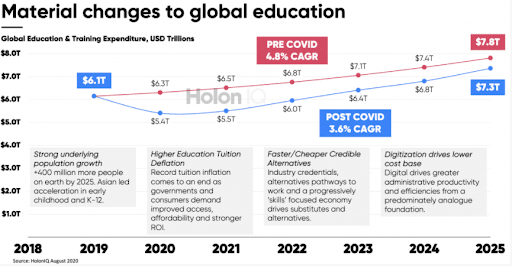Online learning is nothing new. However, due to the Covid-19 outbreak, e-learning has come closer to being the norm.
Despite the inconvenience brought about by school closures, educational technology solutions have allowed classes to continue. Trends like automation, chatbots and immersive learning are key to leveraging growth and elevating the learning experience for students of all ages.
Due to the necessity of distance learning in times of crisis, an opportunity has risen to introduce lasting changes to the classroom that can continue once everything has gone back to normal. In the future, educational technology will revolve around accessibility, versatility, and student-centered learning.
What is Educational Technology
The concept of educational technology — or EdTech — refers to introducing computer technology tools to enhance learning in the classroom.
To put it another way, EdTech is a study field that focuses on improving learning and performance through appropriate technological processes and resources. While this field may seem niche, its potential impacts are far-reaching and affect many segments of society.
Approximately fifty-two percent of surveyed graduate students in the U.S. reported having a better learning experience with their online college-level education than their college-level classroom education in 2019.

As a result, traditional teaching methods have slowly shifted towards more immersive online learning methods. Likewise, the EdTech market is also showing no signs of slowing down, with the global education and training market being expected to reach $7.3 trillion by 2025.
Several trends in learning technology have emerged in recent years, such as accessible mobile devices and artificial intelligence. In addition to enhancing students' learning experience, this technology can also assist teachers in tasks like grading and admissions.
Why Does Educational Technology Matter?
Today, using the internet and computers in classrooms is as common as using textbooks.
When combined with EdTech, these devices can enhance students' performance and engagement. However, EdTech doesn't just benefit students. Automating grading reduces the burden on educators and allows them to focus more on enhancing the learning experience for students.
Some other big advantages of EdTech include:
- Incorporation of different learning styles;
- Improved student-teacher connection;
- Widespread adoption of hybrid learning models;
- Increased access to higher-level education.
.png)
Students are diverse, and adjusting learning plans accordingly can be challenging. The beauty of EdTech is that it allows teachers to use technology to determine the needs and requirements of every student and create customized solutions based on those results.
Students already use technology in their daily lives, so it makes sense to take advantage of that technology to further their education. By utilizing EdTech, educators can engage their students more effectively and educate them interactively, all from the comfort of their own homes.
Trends That Impact Online Learning
In the past few decades, instruction has changed dramatically, particularly in the Adult education department.
As a result of the Covid-19 crisis, online learning by adults has significantly increased. Because of the pandemic, academic training has evolved significantly. Online courses have largely replaced face-to-face classes in a classroom setting, which has changed how students receive their education.
In this sense, the crisis serves as an effective test of the potential of online learning. Additionally, it highlights the challenge of delivering traditional work-based learning online and the difficulties teachers face when they may not be as tech-savvy. Taking these issues into account could lead to the expansion of online learning in the future.
While there are many challenges to online learning, here are the five trends that have impacted EdTech the most.
Collaborative Learning
With the help of technology, everyone is connected. Connecting, discussing, and taking action are all a part of the collaborative process. Since online collaboration has become integral to most office jobs nowadays, using this technology early on can give a student a much-needed advantage.
Getting experience from working together will benefit them throughout their careers. Collaboration allows students to better understand the material, which in turn allows them to work more productively with coworkers or even prepare them for a leadership role in the workplace.
EdTech, in particular, has the advantage of making collaboration easier for students and educators alike. Traditionally, students collaborate in the classroom and leave when class is over to work separately from home. In today's world, technology has bridged the gap between the classroom and home.
Platforms like StuDocu are a new type of trend in EdTech, enabling peer-to-peer document sharing. Document sharing makes it easier than ever for peers to collaborate when not in the classroom.
Artificial Intelligence and Chatbots
Artificial intelligence or AI has officially arrived at higher education.
AI is defined as computer programs that learn from human logic and reasoning to perform tasks independently, simplifying workflows and processes for organizations. Additionally, AI is slowly finding its way into the different fields of higher education.
For one thing, it has a lot of universal applications, some of which include:
- Better accessibility: Students can turn to chatbot assistants anytime and anywhere.
- Objectivity: This makes it possible for a more objective means of assessing knowledge in the future.
- Self-study tool: chatbots can help students systemize their self-educational activities.
- Availability: as mobile apps, web tools, and on social media.
When harnessing AI to boost student outcomes, higher education institutions can also predict enrollment trends, optimize recruitment, and elevate student achievement. With AI performing time-consuming tasks, administrators can refocus their efforts on improving student experiences in their schools instead of wasting time on repetitive tasks.
College recruiting teams can also focus their efforts and time more effectively by creating algorithms that can predict the applicants most likely to enroll, the states from which they will come, and the countries from which they will arrive.
More Automation in School
Currently, many schools use online assessments that are interactive, flexible, and efficient.
One tool to help with this is workflow automation. In the business world, automation is the creation and application of technology to monitor and control the production and delivery of products and services.
People in the education department primarily use automation to reduce workloads. Teachers can use learning analytics to get information about students’ interactions with online technology by looking at their digital footprint.
Adding more smart tools to schools, including face recognition technology for taking attendance, autonomous data analysis to inform learning decisions, and automating administrative tasks, all change education for the better.
Automation will also lower building costs by automatically controlling heating, ventilation, and lighting systems, which can also safeguard students by automatically controlling school security systems.
Use of VPNs
It’s important to ensure that the basics of online learning security are covered on all devices, including software.
Resorting to a VPN when learning online can greatly improve security for your students. The main advantage of using a VPN is that it encrypts your data. When data is encrypted, it can make any system seem anonymous and hard to track online.
With the influx of great VPN services, like NordVPN, readily available, students from all over the world can access content from anywhere. This gives online learning platforms a truly global reach.
.png)
Students and faculty members benefit from implementing industry-leading data security measures in educational institutions so everyone’s information can be safe.
The threat of cybercrime has become a source of concern for everyone, even in the educational sector. Students' personal information such as their names, emails, dates of birth, and phone numbers cannot be compromised. In addition, many cloud services store test and assignment results.
Thus, users can rest assured that their data is secure as it is shared back and forth between students, educators, or other staff members.
Online Learning Makes Higher Education Accessible
The financial constraints of going back to school are one of the most common roadblocks that may keep people from trying to earn a degree.
Because of its flexibility, online learning opens up the possibility of graduation to more adult learners. In the past, many adults have given up jobs, renegotiated hours, and got less pay to attend classroom-based learning.
In addition to tuition, campus-based programs often come with additional student fees, pricey textbooks, and living or transportation costs. However, many online degree programs can help students reduce the expenses of earning a degree — whether through savings on the cost of the school itself or by saving the cost of traveling to campus, hiring additional childcare, or reducing work hours.
Now that EdTech has found its place, students can access their courses anywhere from their smartphones or personal computers. Sixty-seven percent of American college students are already using their mobile devices to complete all or some of their course-related activities.
The Future is Tech
Life and interaction are being transformed by technology at an accelerating pace.
Education has the power to change the world for the better, which is why it’s critical to introduce technology into the curriculum.
Educators worldwide can benefit from EdTech by eliminating current barriers to quality education. By using technology in education, students can extend their imaginative range and gain better comprehension at all levels.


.jpg)
.jpg)




.jpg)


%2520(1).jpeg)

.jpeg)




.jpeg)






%20(1).png)
.png)
